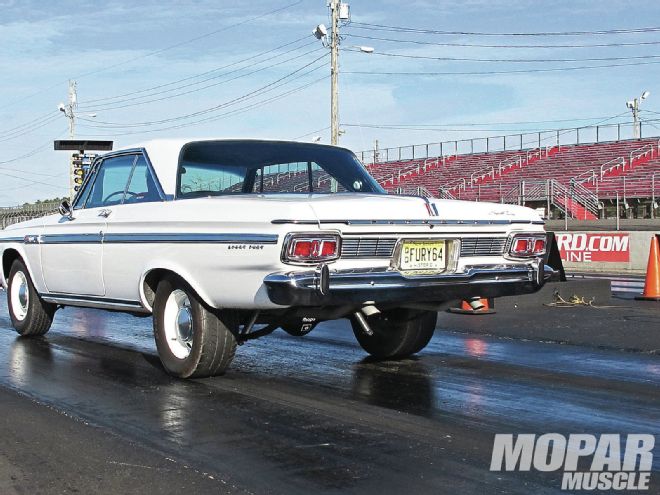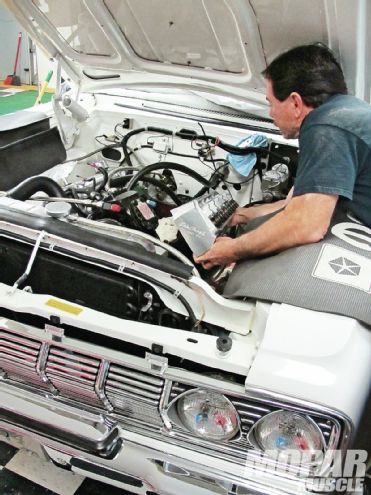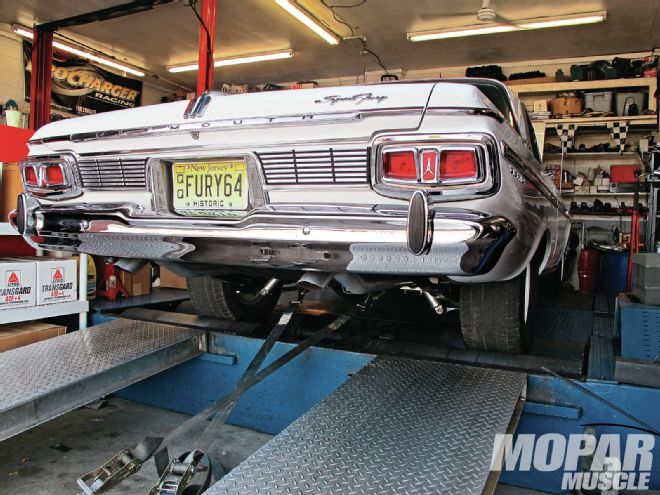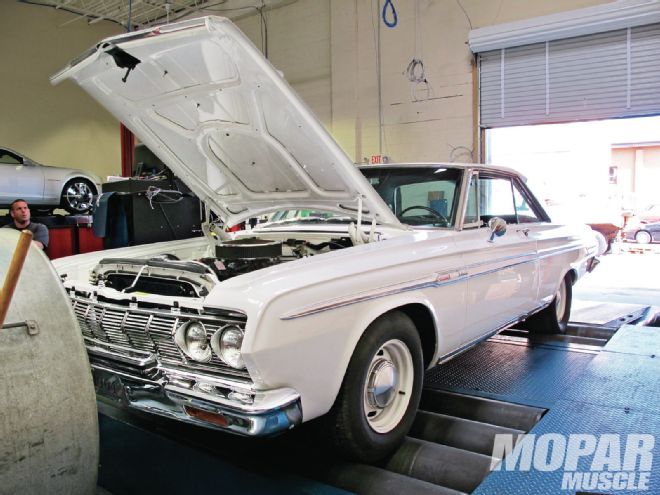
Back in the ’90s, we did a dragstrip comparison test between 2 1⁄2-inch compression-bent exhaust, and a 3-inch mandrel-bent TTI system on a ’67 Coronet R/T with a 440. That swap helped the 440, and the car dropped 3/10ths of a second in the quarter-mile, and picked up 3 mph. At that time, another better-breathing exercise was to port stock heads, as the now popular Edelbrock aluminum heads weren’t in production yet. Two different sets of ported stock heads were strip-tested, using the templates available from Mopar Performance (remember them?). For one test, we used a set of 915 heads that I ported for the 383 in my daily-driven ’65 Coronet. The other set was a pair of 906s for the 440 in my ’67 R/T. These ported heads brought gains of 4/10th of second and 4 mph on both the 383 and the 440. This all makes sense when you consider roughly 40 cfm of flow was gained at each intake port.
 The Fury’s powerplant is a 1978 cast-crank 440 with 452 heads, a Mopar Performance Street Hemi grind cam with .474-inch lift and 280 degrees advertised duration (238 degrees @ .050-inch, 110-degree LSA), stock stamped-steel rockers, an Edelbrock Performer RPM intake with an 850 Holley, Performance Distributors’ Tri Power ignition with Livewires, and TTI 13⁄4-inch headers. This test is to show the gains of a true exhaust and head swap only. We could have gained even more power by swapping to a modern roller cam with adjustable rockers to take advantage of the better flowing heads.
The Fury’s powerplant is a 1978 cast-crank 440 with 452 heads, a Mopar Performance Street Hemi grind cam with .474-inch lift and 280 degrees advertised duration (238 degrees @ .050-inch, 110-degree LSA), stock stamped-steel rockers, an Edelbrock Performer RPM intake with an 850 Holley, Performance Distributors’ Tri Power ignition with Livewires, and TTI 13⁄4-inch headers. This test is to show the gains of a true exhaust and head swap only. We could have gained even more power by swapping to a modern roller cam with adjustable rockers to take advantage of the better flowing heads.
The old theory is that to shave a tenth in e.t., you need to roughly increasing power by 10 hp on the average 11-second or slower car. We wanted to put these mods to the test again. The mule this time would be a friend’s beautiful ’64 Sport Fury, AKA “The Balls of Fury.” It is powered by a mildly-built 440 from Muscle Motors that was assembled in 1999. Instead of home-porting a set of stock heads (30 to 60 hours of grueling work), this time we would bolt on a set of Edelbrock’s Performer RPM aluminum heads.
Originally, we wanted to try its new E-Street heads, which are a lower-cost alternative to the Performer RPMs, but we discovered our test car’s engine had quench dome pistons, which dictated we use open chamber heads. The E-Streets are only available with a closed chamber, and that would not work with our 440.
An out-of-the-box set of Edelbrock (E-Street or Performer RPM) heads will flow about 60 cfm more air than stock iron heads (915, 906, or 452). Also, the new aluminum castings take nearly 50 pounds off the nose of the car. It’s next to impossible for most people to port and polish a stock set of iron heads, and have them be comparable in performance to the new lighter aluminum castings. A few experts can rework and port stock heads to accomplish comparable flow numbers, but it will cost you more coin than buying a new set of Edelbrock aluminum heads.
For this test, the first bolt-on was to replace the 2½-inch exhaust with a 3-inchTTI system. The larger diameter exhaust would allow the 440 to breathe easier before performing the head swap. The strip and dyno testing results for both the exhaust and head swap were quite satisfying, to say the least. A 3-inch exhaust is most beneficial on a 440 and bigger engine. It’s been our experience that it is not worth using a 3-inch exhaust on a mild 383 or a 340/360 small-block producing less than 450 horsepower, although better flowing heads are beneficial on most any engine. Follow along, and check out how easy it is to turn a mild-mannered 440 into an asphalt-shredding monster with no loss of drivability.
06 Gains of over 30 rwhp, and a 3/10ths of a second (12.93 to 12.60) drop in ET were very rewarding from just a simple exhaust swap. Our friends at Tune Time Performance in Lakewood, New Jersey, graciously let use their Mustang dynamometer to dyno test the car. At the track, the Fury was quicker and faster—it boogied to a 12.60 at 106.14 mph. The Fury’s owners couldn’t believe how much stronger the car felt from the just upping the exhaust size! "> <strong>06</strong> Gains of over 30 rwhp, and a 3/10ths of a second (12.93 to 12.60) drop in ET were very rewarding from just a simple exhaust swap. Our friends at Tune Time Performance in Lakewood, New Jersey, graciously let use their Mustang dynamometer to dyno test the car. At the track, the Fury was quicker and faster—it boogied to a 12.60 at 106.14 mph. The Fury’s owners couldn’t believe how much stronger the car felt from the just upping the exhaust size!
13 On the previous dyno test of the TTI exhaust, air/fuel (A/F) ratio was an ideal 12.8 to 12.9 after swapping the heads, the first two pulls showed the engine to be a litter rich with an A/F of 12.0 to 12.2. Next, the jets were stopped down to sizes on the secondary side. The brought the A/F back to an ideal 12.9 average during the pull, while rewarding us with 4 rwhp.
Upgrading to the new heads netted this mild 440 a gain of 51 rwhp. That’s a substantial power gain, when considering the mild cam grind (.447-inch) that does not support airflow compared to today’s modern cams with more valve lift (.500-inch plus) for the same duration to take advantage of the higher-flowing heads.">
<strong>06</strong> Gains of over 30 rwhp, and a 3/10ths of a second (12.93 to 12.60) drop in ET were very rewarding from just a simple exhaust swap. Our friends at Tune Time Performance in Lakewood, New Jersey, graciously let use their Mustang dynamometer to dyno test the car. At the track, the Fury was quicker and faster—it boogied to a 12.60 at 106.14 mph. The Fury’s owners couldn’t believe how much stronger the car felt from the just upping the exhaust size!
13 On the previous dyno test of the TTI exhaust, air/fuel (A/F) ratio was an ideal 12.8 to 12.9 after swapping the heads, the first two pulls showed the engine to be a litter rich with an A/F of 12.0 to 12.2. Next, the jets were stopped down to sizes on the secondary side. The brought the A/F back to an ideal 12.9 average during the pull, while rewarding us with 4 rwhp.
Upgrading to the new heads netted this mild 440 a gain of 51 rwhp. That’s a substantial power gain, when considering the mild cam grind (.447-inch) that does not support airflow compared to today’s modern cams with more valve lift (.500-inch plus) for the same duration to take advantage of the higher-flowing heads.">
 <strong>13</strong> On the previous dyno test of the TTI exhaust, air/fuel (A/F) ratio was an ideal 12.8 to 12.9 after swapping the heads, the first two pulls showed the engine to be a litter rich with an A/F of 12.0 to 12.2. Next, the jets were stopped down to sizes on the secondary side. The brought the A/F back to an ideal 12.9 average during the pull, while rewarding us with 4 rwhp.
Upgrading to the new heads netted this mild 440 a gain of 51 rwhp. That’s a substantial power gain, when considering the mild cam grind (.447-inch) that does not support airflow compared to today’s modern cams with more valve lift (.500-inch plus) for the same duration to take advantage of the higher-flowing heads.
<strong>13</strong> On the previous dyno test of the TTI exhaust, air/fuel (A/F) ratio was an ideal 12.8 to 12.9 after swapping the heads, the first two pulls showed the engine to be a litter rich with an A/F of 12.0 to 12.2. Next, the jets were stopped down to sizes on the secondary side. The brought the A/F back to an ideal 12.9 average during the pull, while rewarding us with 4 rwhp.
Upgrading to the new heads netted this mild 440 a gain of 51 rwhp. That’s a substantial power gain, when considering the mild cam grind (.447-inch) that does not support airflow compared to today’s modern cams with more valve lift (.500-inch plus) for the same duration to take advantage of the higher-flowing heads.
Dyno and dragstrip results MODS HP TQ 60-FT E.T. MPH Baseline, 2½-inch TTI Exhaust 298/5,500 327/4,400 1.85 12.93/103.01 3-inch TTI Exhaust 328/5,700 385/4,400 1.78 12.60/106.14 Edelbrock Heads 379/5,900 436/4,400 1.71 12.07/111.42